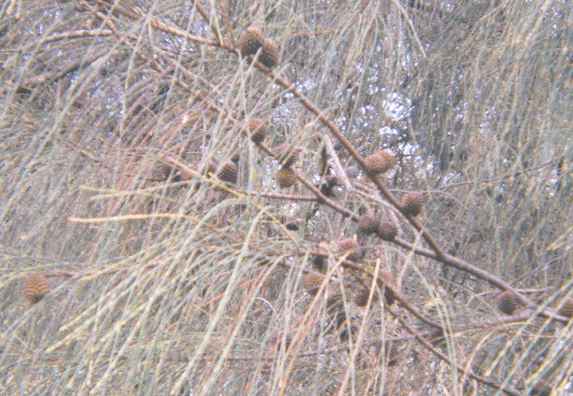- Allocasuarina
Taxobox
name = "Allocasuarina"

image_width = 240px
image_caption = "Allocasuarina verticillata" foliage and fruit
regnum =Plant ae
divisio = Magnoliophyta
classis = Magnoliopsida
ordo =Fagales
familia =Casuarinaceae
genus = "Allocasuarina"
genus_authority = L.A.S.Johnson
subdivision_ranks = Species
subdivision = 61 species; see text."Allocasuarina" is a
genus in theflowering plant familyCasuarinaceae . They are endemic toAustralia , occurring primarily in the south. Like the closely related genus "Casuarina ", they are commonly called sheoaks or she-oaks, they are notable for their long, segmented branchlets that function as leaves. Formally termedcladode s, these branchlets somewhat resemblepine needles, although sheoaks are actuallyflowering plant s. The leaves are reduced to minute scales encircling each joint. Fallen cladodes form a dense, soft mat beneath sheoaks, preventing the development of undergrowth and making sheoak woods remarkably quiet.Another characteristic feature are the spiny "cones", about the size of an
acorn but with a texture more resembling aconifer cone . However, sheoak "cones" are actually a woodyfruit .As with
legume s, sheoak roots possess nodules containingsymbiotic nitrogen fixing bacteria; together with their highlydrought adapted foliage, this enables sheoaks to thrive in very poor soil and semi-arid areas. However, sheoaks are much lessbushfire tolerant thaneucalypt s.Fossil s of closely related species have been found dating back to the time ofGondwana .Uses
The hard wood and rich texture makes sheoak wood popular among wood-turners. Sheoak wood is also regarded as an excellent firewood as it burns with very little ash.
Because of its ability to grow and develop extensive root systems in very poor or sandy soils, and to completely cover the ground with its "needles", it is often used to stabilise soils in
erosion prone areas, or onsand dune s. Sheoak is also used as an ornamental shrub, although for this purpose the mat of "needles" may become a nuisance and must be carefully considered.List of "Allocasuarina" species
References
External links
*
* [http://www.bushcare.tas.gov.au/info/sheoak.htm She-Oak Woodland & Forest (Tasmania Government)]
* [http://www.mpl.ird.fr/rhizo Research team] from [http://www.ird.fr IRD] working onCasuarinaceae
Wikimedia Foundation. 2010.
